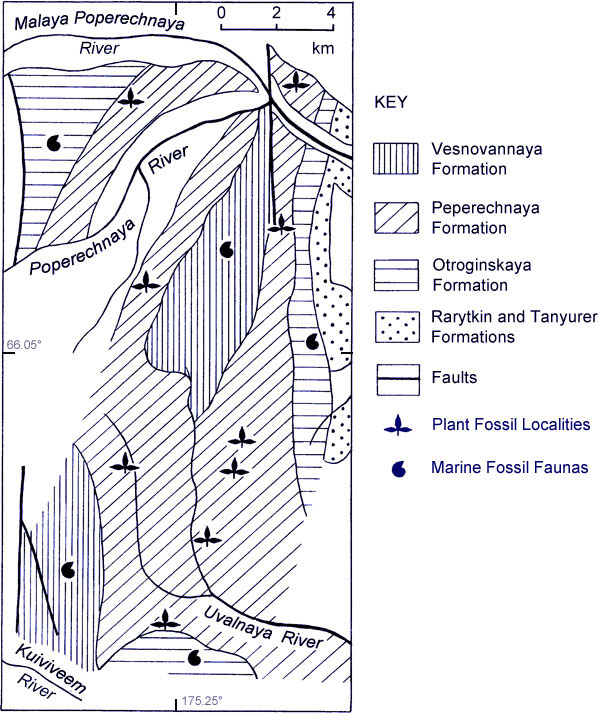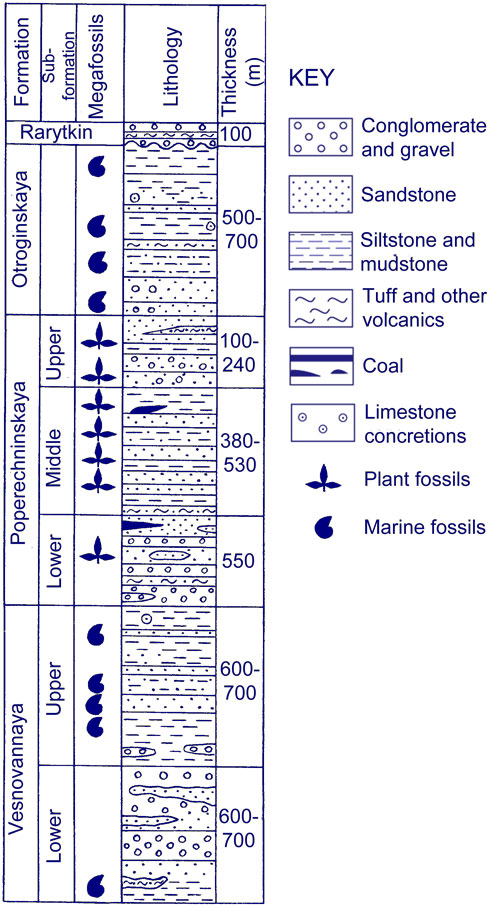Pekul'nei Ridge (Eastern Slope)
| Introduction | Pekul'nei East | Pekul'nei West | NE Russia Map | The Flora | Fossil Images |
|---|
Lithology and StratigraphyUpper Cretaceous deposits on the eastern slopes of the northern Pekul'nei Ridge, extend southwards from the Malaya Poperechnaya River, along the banks of the Poperechnaya and Uval’naya rivers, to the Kuiviveem River in the south (see map to right). Marine deposits of the Vesnovannaya Formation make up the lowermost Upper Cretaceous units in this succession(see below right). The Vesnovannaya Formation is up to 1400 m thick and is divided into two subformations (Terekhova and Filippova, 1983), each being approximately 600 - 700 m thick. The Lower Subformation consists predominantly of conglomerates with rare sandstone and siltstone beds. These fine-grained deposits yield Inoceramus sp. indet., Gokoyamaoceras sp. indet., and fragments of ammonites and echinoids. The Upper Subformation is largely made up of siltstones with interbedded sandstones, and rare occurrences of conglomerates and tuffs. Fossil mollusc remains include Inoceramus ex gr. korjakensis Ter., I. gradilis Pergament, I. aff. tenuis Mantel., I. aff. tychljawajamensis Ver., I. multiformis Pergament, I. cf. cuvieri Sowerby, I. cf. hobetsensis Nagao et Mat., I. cf. mametensis Pergament and I. aff. concentricus var. costatus Nagao et Mat. The ammonite Scaphites sp. (S. pseudoaequalis Yabe or S. yonekurai Yabe) has also been found. Terekhova (Terekhova and Filippova, 1983) correlated the Lower Subformation with the Inoceramus nipponicus zone (Cenomanian and Lower Turonian), and the Upper Subformation with the Inoceramus iburiensis zone (Upper Turonian), thus indicating that the Vesnovannaya Formation is Cenomanian to Turonian in age. Conformably overlying the Upper Vesnovannaya Subformation are plant-bearing deposits of the Poperechnaya Formation, which in places is up to 1300 m thick. This is divided into three subformations (Terekhova and Filippova, 1983) (see lithostratigraphic chart to the right). The Lower Subformation is approximately 550 m thick and is composed of sandstones lenses of conglomerates with occasional layers of siltstones and tuffs. The upper part of this succession is dominated by conglomerates with interbedded layers of gravels, and cross-bedded coarse-grained sandstones with rare occurrences of coal. The Middle Subformation, 380 - 530 m thick, is generally finer grained and yield an abundance of plant fossil remains. It is composed of interbedded sandstones, siltstones, mudstones and coaly siltstones, small lenses of coal and tuffs. The Upper Subformation is 100 - 240 m thick and is made up of interbedded conglomerates, gravels, sandstones and rare siltstones and tuffs. Plant fossil remains are found in all the subformations, but the Middle Subformation provides the richest source. The overall suite of facies is indicative of a floodplain environment with high rates of deposition. The Poperechnaya Formation is conformably overlain by marine deposits of the Otroginskaya Formation which is between 500 and 700 m thick. Siltstones with interbedded sandstones and tuffs characterise this formation. Fossil mollusc remains include Inoceramus yokoyamai Nagao et Mat., I. cf. naumanni Yok., I. sp. indet. (I. cf. amakusensis Nagao et Mat.), Gaudryceras cf. denseplicatum (Jimbo), Neopuzosia ishikawai (Jimbo) and Yokoyamaoceras cf. kotoi (Jimbo). Terekhova (Terekhova and Filippova, 1983) considers that the fossil-bearing parts of the Otroginskaya Formation belong to the Inoceramus yokoyamai zone of Upper Coniacian to Lower Santonian age. The age of the Poperechnaya Formation, and hence the Poperechnaya Flora, is constrained biostratigraphically by underlying marine deposits of the Vesnovannaya Formation of Late Turonian age and by overlying marine deposits of the Otroginskaya Formation of Late Coniacian to Early Santonian age. The Poperechnaya Flora is thus Early Coniacian and correlates with the Inoceramus uwajimensis zone (Craggs, 2005).
|
Map showing positions of the Eastern Pekul'nei Ridge (Poperechnaya Formation) taphofloras.
Lithologies and stratigraphy of sediments exposed on the eastern side of the Northern Pekul'nei Ridge. |
|
The Poperechnaya FloraAll three sub-formations of the Poperechnaya Formation yield plant fossils, but they are most abundant in the Middle Subformation, where they form large leaf accumulations. Filippova (1991, 1994) identified 62 different species, and regarded the taxonomic composition as sufficiently uniform throughout the succession for it to be considered as containing a single floral association, subsequently named the Poperechnaya Flora by Herman (1999). Based on the number of species the Poperechnaya Flora is dominated by angiosperms (approximately 50%), followed by conifers, ferns and other plants, as in the Tylpegyrgynai Flora. Angiosperm leaves are the most abundant floral component and have the greatest taxonomic diversity. Platanoids form the dominant group with genera such as Arthollia, Paraprotophyllum and Pseudoprotophyllum being the most widespread, particularly in the Middle Subformation where they sometimes form large leaf mats. Some platanoid leaves are more than 20 cm in length, but smaller leaves with acrodromous venation are represented by several species of Trochodendroides and Zizyphus. Other less frequently found genera include Menispermites, Araliaephyllum, 'Viburnum' (Viburniphyllum), Celastrophyllum, Leguminosites, and Terechovia. The most abundant conifers are Cephalotaxopsis and Sequoia, often associated with Metasequoia and Thuja (Cupressinocladus). Ferns are rare, but include Osmunda sp. and Coniopteris. Cycadophytes are even rarer and are only represented by Ctenis sp., while the ginkgoales are represented by by Ginkgo ex gr. adiantoides. Czekanowskiales may be represented by the genus Phoenicopsis, although only isolated linear leaves have been found that are referred to the form genus Desmiophyllum. |
||


